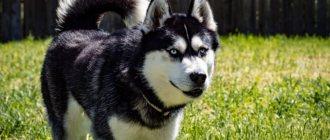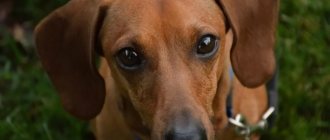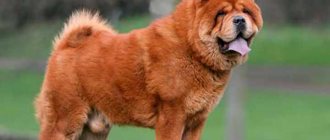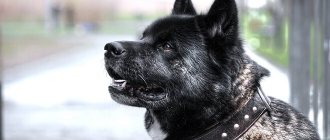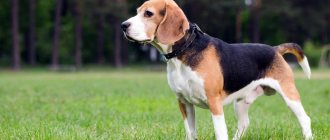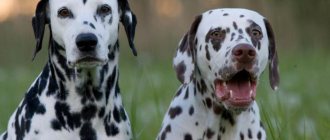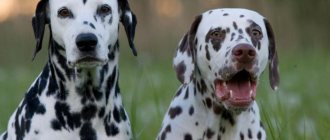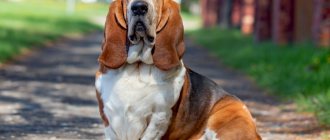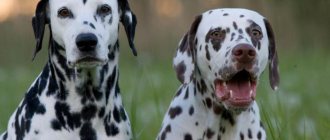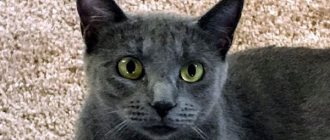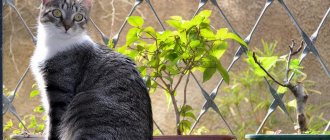Russian dog breeds
Among the breeds belonging to the Russians, there are both hunting and decorative dogs, good companions. Each individual has a different character, training and maintenance. Therefore, it is worth familiarizing yourself with the representatives of Russian dogs in more detail.
Alabai
Alabais are distinguished by absolute loyalty to their owner and fearlessness. The average weight of males is 70 kg, and females - 50-60 kg. The dog is large, the boy can reach 70 cm at the withers. Fully grown only by 3 years. Individuals live on average from 11 to 15 years.
Alabai is a brave and courageous dog. He is able to protect himself and his owner. Aggressively perceives strangers, both people and animals. But family members can be loved. The dog is smart enough to become a good guard.
It will be difficult to keep such a pet in an apartment. The best option would be a large house with a plot. It is important to position your pet’s booth so that he has a full view of the entire territory around the clock. The dog needs regular walking, at least 2 times a day. It is enough to bathe it annually, and it is worth combing only when the pet begins to shed.
When training, the owner must position himself as a leader. How successfully your pet will obey depends on how you position yourself correctly. He can trust the leader and carry out all commands and assigned tasks.
East European Shepherd
Another representative of excellent guards. Differs in balance. They get along well with family members and other animals. When raising and training, it is necessary to be persistent.
East European Shepherds are quite large. Males reach a weight of up to 60 kg, while girls can weigh 50 kg. Height varies depending on gender and is 66-76 and 62-72 for boys and girls respectively. They live on average 13 years. Thanks to its thick coat, the pet can withstand difficult climatic conditions.
For quality training, the owner must immediately begin to demonstrate leadership qualities. The pet should see him as the leader of the pack. When training, the owner must also have basic knowledge about the upbringing and character of this breed.
It is better not to keep your pet in the apartment. It is recommended to build or purchase an enclosure for him. Such conditions will be quite comfortable for the pet. It needs to be washed every week, and during the shedding period it needs to be combed every few days.
West Siberian Laika
Photo from Wikipedia website
The dog is distinguished by well-developed muscles and tall stature. It can reach 60 cm in males and 58 cm in females. The dog's weight is about 16-22 kg. The pet has thick and long hair, and the undercoat is dense and soft to the touch.
By nature, the pet is affectionate and devoted. He can become strongly attached to his family and is unfriendly towards strangers. The hunter's instinct does not allow the individual to get along with other animals; it can chase small rodents and cats. Outside of hunting, she is not aggressive, quite balanced.
It is recommended to start training from the age of 3 months. The dog is stubborn and quickly loses interest in training. This is important to consider in order to conduct your training as efficiently as possible. They start by teaching basic commands and only then begin to actively develop hunting skills.
You can keep your pet in an apartment, but the best option is a spacious yard with an enclosure. This way the dog will have enough space to frolic and it will be more convenient to train him. The characteristics of the breed are such that representatives of this species prefer suburban conditions rather than life in a metropolis.
Caucasian Shepherd Dog
Large pets, whose weight can reach 75 kg. Also quite tall. At the withers, the height is about 68-75 cm. Such shepherd dogs live on average 11 years. Their peculiarity is their lightning-fast reaction. They love only family members and treat strangers with extreme suspicion. Shepherd dogs are quite sensitive, even in their sleep they can detect subtle sounds or rustles. They are easy to anger, have excellent intuition and easily determine the degree of danger.
Training and socialization must begin when your pet is still a puppy, from the moment he appears in the family. This is especially true for pets who live in an urban environment. They must react normally to the flow of cars and people.
Favorable living conditions include a large plot and an enclosure. The animal may feel too cold in the apartment. It is necessary to periodically wash your pet and comb it when shedding begins.
Moscow guard dog
Photo from Wikipedia website
The animal is large in size and muscular. His weight reaches 55 kg, and his height is 68 cm. But the girls are more graceful and somewhat smaller than the males. The thick and long coat feels rough to the touch. It may have a spotted color, in which the spots have a variety of shades, including red and black. Such dogs live on average about 12-13 years. They are hardy and can withstand even severe frosts.
A large private yard becomes an ideal place to keep it. There the pet will have somewhere to roam. But a pet is also suitable for an apartment. In this case, it is necessary to constantly walk him and comb him at least several times a week.
Training begins in puppyhood. When a pet appears in the house, they immediately begin to socialize it. He must know and follow the rules of conduct in the house and with family members. The main thing is that the owner establishes mutual understanding with the pet.
Russian hound
Photo from Wikipedia website
The animal is medium in size, but has a strongly built body. Weight reaches 30 kg and height 68 cm. Individuals live for about 12-16 years. Great for hunting. The distinctive features of the animal are good obedience and energy. Reacts normally to children. The hound barks loudly. In hunting or nature conditions this is a normal phenomenon, but in an apartment or house the owner will need to control the pet’s desire to speak loudly.
It is better to keep it, like previous animals, on the site. Living in an apartment for a hound can be inconvenient for both the pet and the owners. The enclosure should be spacious; it is better to supplement it with a warm, suitable-sized booth. The peculiarity of the breed is that the animal needs long walks, and this must be taken into account.
The hound is distinguished by its quick wit and developed intelligence. Therefore, it remembers commands quite quickly and easily. It’s better to take your pet for a walk first, then start training. Basic commands are learned at puppy age, starting from 4 months, it is worth developing hunting skills.
Russian piebald hound
Photo from Wikipedia website
Another type of hound. Weighs about 35 kg, grows up to 68 cm, life expectancy is 14-16 years. An animal with a pronounced hunter instinct. Outside of hunting, he behaves calmly and balanced. It is independent and is not friendly with small pets, seeing them as prey. Does not show obvious aggression towards strangers.
Pets have a good level of intelligence and excellent memory. They remember commands quickly, but difficulties in training may arise due to the pet’s desire to show leadership qualities and independence. Therefore, it is important that the owner shows firmness. He must show himself as a leader and always have the last word.
In the summer, a pet can live outside in an enclosure or kennel, but in winter it is recommended to move it indoors so that it does not freeze. The dog is active, so he needs regular walks and more space where he can run.
Russian greyhound
Photo from Wikipedia website
Representatives of this species reach a size of up to 86 cm and a weight of up to 45 kg. They can live on average 10-12 years. They are excellent hunters, but are completely unsuitable for protection. The pet has a balanced character, calmness and lack of aggression. Even a simple bark from him will be difficult for an outsider to hear. At home he shows melancholic character traits, but when hunting he is active and passionate.
When training, the owner must behave respectfully. It is important not to let the pet perceive that the owner is trying to humiliate his dignity. Training will require a lot of patience. The main thing is that the owner is able to formulate distinctions among the pet regarding ordinary life and hunting. They are unpretentious in their maintenance, so you can place your pet even in an apartment.
Russian hunting spaniel
Photo from Wikipedia website
Spaniels weigh up to 16 kg with a height of up to 44 cm. They are not the largest individuals and have an average life expectancy of 12-14 years. The animal is an excellent hunter. Has good stamina, energy, tenacity and an excellent sense of smell. Needs good training to calm down his hunter's ardor at home.
An easy-going pet that has a positive attitude towards children. You need to start training your spaniel right away. They start with basic commands, then begin training hunting skills. It is important to raise a pet so that it approaches its owner at his first request. Spaniels are prone to running away, so you need to be able to quickly call the animal to you.
A house or apartment is perfect for a spaniel. You can move it into the yard only in the warm season. It is necessary to regularly walk and play with your pet.
Russian toy terrier
Photo from Wikipedia website
A small individual that weighs 3 kg and has a height of up to 28 cm. Life expectancy is about 12 years. Has a friendly disposition. Accepts children and elderly people well. The pet loves attention, he is cheerful and active.
Many people mistakenly believe that the baby does not require training. This is not true. It is necessary to start training from the first day the pet appears in the house. You can teach him the rules of behavior in the house and basic commands. It is important not to dominate when training, so as not to scare your pet. It is better to act persistently and patiently.
Perfect for keeping in an apartment. Does not require much space or special care.
Black Russian Terrier
Their life expectancy is 11 years. They reach a weight of up to 50 kg and a height of up to 72 cm. The pet slowly matures. It is fully formed only by 2.5 years. An excellent guard, distinguished by his devotion. He is distrustful of strangers, but does not show strong aggression towards them. Does not seek to cause harm to the enemy, but only strives to ensure that the enemy runs away.
Training begins at an early age. It is necessary to take the training process seriously and actively demonstrate leadership qualities. This will demonstrate to the pet that the owner is the leader. The ideal place for keeping is a country house and plot. It will be problematic to keep such an individual in an apartment.
Siberian Husky
Good-natured and friendly pets can weigh up to 28 kg. Their height is 60 cm and they live on average 13-15 years. The pet is open to communication, active, and energetic. They are sled dogs, so huskies need regular, sufficient exercise.
They have a tendency to run away. When training, you must remember that the pet is not a service animal. Therefore, training is easy, but the pet will obey only one leader. The owner should be firm and strict.
You can keep it in an apartment, but it is important to ensure that the husky is physically loaded as much as possible. This will avoid the possibility that your pet will run away or feel unwell.
What varieties exist, features
Dog breeds bred in the countries of the former USSR are assigned to Russia. Among these are the Caucasians, who were bred in Urartu. However, the Russian Canine Association decided to classify these breeds as domestic.
At the moment, hunting, service and ornamental animals are found on the territory of the Russian Federation. All have a large number of distinctive characteristics. Most of the breeds were bred by Soviet breeders. Modern Russian specialists cannot yet boast of achievements.
How to choose a puppy
Choosing a pet must be approached responsibly. To do everything right, it is recommended to adhere to the following tips:
- Decide on the breed. It could be a hunter, an ornamental pet, or a companion.
- Accommodations. If you plan to take a pet into an apartment, then you should not choose a very large individual that will find it difficult to live in such conditions.
- Pet's character. Quiet and inactive people are not suitable for overly active pets. It is necessary to take into account the rhythm of your own life.
- You should look for a purebred Russian dog in specialized nurseries. It is also important to check all documents and vaccinations.
- Examine the puppy. He should be healthy, moderately active, clean, without a sickly, lethargic appearance.
The described popular breeds were bred in Russia and the USSR. Most of them are quite large individuals and are more suitable for private houses and plots than apartments. Regardless of the choice of breed, it is recommended to immediately begin socializing the puppy and take its care and training seriously.
History of Russian cynology
Cynology in Russia originated on the basis of the national sport - hound hunting. In the development of science, the high level of technical skills of dog breeders was of great importance, since many of them were engaged in horse breeding. The real rise of cynology occurred at the end of the 19th century, when monographs about dogs, their training and education began to be published. Along with the hunting direction, service dog breeding gradually developed. Today, the largest cynological organization in Russia is the Russian Cynological Federation, which has been a partner of the International Federation since 1995, and since 2003 a full member.
RKF has been an active member of the International Cynological Federation since 2003
About 30 breeds are considered Russian, a third of which are already recognized internationally. The main feature is endurance and good health, since most were bred in the harsh northern climate.
Distinctive features
This breed is medium-sized, well-built, with a strong body and well-developed muscles. A feature can be considered long hair and variability of colors. At the withers, the animals reach 36-44 cm, and weigh from 15 to 20 kg.
Spaniels are stretched in structure. Their body length is slightly greater than their height. Their limbs are quite long, which makes them adaptable to running through swamps or snowdrifts. The latest standard was published in 2012.
- The head is dry and long. The skull is oval, with a pronounced smooth stop and brow ridges.
- The muzzle is moderately long, narrow (tapering towards the nose), filled in under the eyes. The jaws are strong but soft, with a full set of teeth and scissor bite The lips are thin and pigmented.
- The nose is wide with open nostrils.
- The eyes are medium-sized, oval, not widely set. The color of the iris depends on the coat color: from light brown to dark brown.
- The ears are set at eye level, long, thin, adjacent to the cheekbones;
- The body is streamlined and strong. The back is long and wide. The loin is slightly convex. The croup is sloping. The withers are pronounced. The chest is deep and well descended. The neck is of moderate length, dry, muscular. The belly is tucked in.
- The tail is a continuation of the croup, moderately long, carried at the level of the back or slightly above it. It is docked by half, unless it is prohibited in the country.
- The limbs are dry, straight, parallel, the hind legs are set wider than the front ones. The paws are oval with gathered toes, characterized by the presence of hair between them. Movement : light gallop.
- The coat is straight or wavy, moderately long, close-lying and shiny. Lengthening is noticeable on the ears, limbs, abdomen, chest and neck.
- Colors: solid, bicolor or tricolor in various variations.
Relationships with children and pets
Unlike many hunting breeds, Russian Spaniels are patient with children. But they experience boundless love only for the children of their master.
Important! Russian spaniels are capable of showing aggression towards unfamiliar children.
From early puppyhood, a curious and energetic spaniel must be taught to treat the pets living in the owner's house loyally and carefully. But, in fairness, it should be noted that hunting habits do not appear on poultry and cats, which dogs simply do not notice.
Basic moments
- The South Russian Shepherd is a rare, almost exclusive breed, the development of which has been negatively affected by commercial breeding observed in recent years.
- Yuzhaka wool produces excellent yarn, from which you can knit or felt beautiful things that have a healing effect.
- In the case of JRO, differentiation on the breeding line is almost never practiced, so the choice of a future service dog and a companion dog has to be done within the same litter.
- One of the favorite pastimes of South Russian Shepherd dogs is digging holes, which, given the size of the breed, are more reminiscent of construction pits.
- Yuzhaks are not recommended for keeping as a first dog, or for people who do not have experience in training working shepherd dogs.
- You will have to take a lot of care for the fur of a show-class pet, and not without the help of groomers. Keep in mind that the fluffy “fur coats” of Yuro quickly fall off, attract small debris and easily change color depending on the diet.
- Paradoxically, although they are not essentially bullies, South Russian Shepherds do not establish contacts well with other dogs and are able to make friends with few of their fellow tribesmen.
The South Russian Shepherd Dog is a shaggy heroine who has established herself as a professional guardian of the owner's peace and well-being. Possessing a serious character and innate suspicion of violators of territorial borders, the Southerners never stir up conflicts from scratch. The only thing you have to take into account when having a South Russian Shepherd at home is the breed’s tendency to be proactive and think for the owner in critical situations.
Who are Molossians
The conventional group of Molosser dogs is united primarily by similar external characteristics, and possibly also by a common origin. In any case, Molossoids can be considered one of the most ancient dogs that have faithfully served humans for several millennia. The very name of the group originates in ancient times, derived from the name of Molossia - the central region of the Kingdom of Epirus, bordering on the west with Ancient Greece.
Works of art from antiquity often depict Molossians (clay figurine, Mesopotamia, 2nd millennium BC)
The impressive appearance of the Molosser, their amazing strength, fearlessness and dedication gained enormous popularity, and the dogs spread widely across different countries in order to, through a process of long-term selection, create the great breed diversity that exists in our time.
The FCI classification divides molossoid breeds into two large subgroups also based on their appearance - the length and structure of the coat are of paramount importance. Great Dane Molossians include mainly service breeds characterized by a short coat that fits tightly to the skin:
- Fila Brasileiro;
- Dogo Argentino;
- English bulldog;
- bullmastiff;
- mastiff;
- Great Dane;
- Rottweiler;
- German boxer;
- broholmera;
- ca de bo;
- mastino napoletano;
- Cane Corso;
- Tosa Inu;
- Shar Pei;
- Dogue de Bordeaux.
The second subgroup is the so-called mountain Molossians; These breeds do not necessarily live in the mountains, but their coat quality is similar: it is thick, shaggy, with an abundant, well-developed undercoat. The mountain category includes breeds for various purposes (herding, service, as well as rescuers and companions):
- cao de serra de zstrela;
- Hovawarta;
- Leonberger;
- Spanish Mastiff;
- Newfoundland;
- sharplaninaka;
- Atlas Shepherd;
- Rafeiro do Alentejo;
- Saint Bernard;
- Pyrenean Mastiff;
- Caucasian Shepherd;
- cao de castro laboreiro;
- Anatolian Shepherd;
- Dogo Canario;
- Central Asian Shepherd Dog;
- Karst Shepherd Dog;
- Tibetan mastiff;
- Pyrenees mountain dog.
Pug and Mastino Napoletano - so different, but both Molossians
Application
The hunting instincts of the Russian Cocker Spaniel allow it to be used as a companion for outdoor games. This dog will tirelessly search for and bring a stick or toy, delighting the kids.
The dog’s increased energy, intelligence, subtle sense of smell, tirelessness, perseverance and patience during long walks and searches for birds are qualities inherent in a hunter, which were instilled through selection. This dog is ideal for hunting wild birds. She also loves to swim, getting birds out of ponds.
For an owner who loves long hikes in nature, a dog of the Russian Spaniel breed will become a faithful companion.
Russian-European Laika
Typically a hunting dog, the Russian-European Laika was developed in the late 1960s from crossing several Laika breeds. The medium-sized black and white husky is loved by fishermen in different areas.
This dog is called a hunter from God. It is used for bears, small fur-bearing animals and birds. Hunters consider her not an assistant, but a companion in the hunting business. The Russian-European Laika is an active, strong and reliable dog with an excellent sense of smell and a very pleasant appearance. She treats people kindly, but is very aggressive towards animals. That's why she was taken out.
Basic moments
- The Russian Greyhound is an excellent hunter and an equally wonderful friend, but other canine professions are not given to this breed. In particular, having entrusted the greyhound with the protection of your own home, do not be surprised if everyone who is not too lazy to enter it.
- In everyday life, Russian greyhounds are relatively calm and not at all aggressive: in order to provoke a dog to bark, you will have to try very hard.
- Hunting instincts guide Russian greyhounds even on regular walks. Cats, rodents and other small animals for these dogs are just game that must be caught immediately.
- A dog can only come to terms with the presence of a meowing creature in his life if he had to grow up with it.
- The Russian greyhound is a fairly athletic breed, whose representatives show good results in obedience and agility.
- The dry, well-groomed fur of Russian greyhounds has virtually no odor, and this is no coincidence. When hunting, a dog does not need extra scents, as they can alert a wild animal. But animals caught in the rain or swimming in an open reservoir can exude a characteristic “amber.”
- The Russian greyhound is a breed that vitally needs to give vent to its own energy and hunting instincts, so you will have to make the most of walking and training with your pet.
- In an informal setting, in the company of the owner, Russian greyhounds are soft and pliable. However, these proud “aristocrats” will not take on any obligations, much less serve a person.
The Russian greyhound is a breed with a centuries-old history and an aristocratic past, which not every hunting enthusiast could afford to keep in the 19th century. Recently, Russian greyhounds have slightly departed from the traditions of their ancestors and more often chase mechanical “hares” across fields than real scythes, but they have not completely lost their qualifications. To make sure of this, it is enough to let your pet off the leash during a walk and watch how dashingly he takes on any four-legged creature that is inferior to him in size.
Classification
They differ in the methods of hunting the animal:
- Weld hunting, when the dog works in a group.
- Working on a blood trail. Allows you to pursue an animal wounded by a hunter and catch game.
- Trace rocks. Due to a particularly developed sense of smell, they track prey, find holes, and drive them in.
- For hunting on foot. They recognize traces and notify about their location.
- Complex baiting, catching an animal. Horses are used for riding hunters, the pack accompanies, finds the wounded animal or reports the victim with a sonorous bark.
A special group is gun dogs. They are not afraid of loud sounds or gunshots. Their task is to find prey and hunt down the beast.
Caucasian Shepherd Dog. Hardy intellectual
The Caucasian Shepherd is the oldest breed of working dog and one of the largest in the world. The immediate ancestor of the “Caucasian” is considered to be the Tibetan Great Dane. The breed received its name due to the territory where it was finally formed. It came to the Caucasus from Central Asia along with the tribes of ancient shepherds.
The history of the breed dates back to the times when man tamed sheep and began to need to protect his flock from attacks by predators or attempts to capture them from foreign tribes. This role could only be entrusted to the best dogs, those who had courage, had a keen eye and a keen sense of smell, were able to go for a long time without food, endure pain, and were at the same time devoted to their owner. These skills and qualities were fixed at the genetic level. This is how the Caucasian Shepherd Dog was born, whose temperament was influenced by clashes between different tribes. The “Caucasian” combines aggressiveness towards strangers and a jealous attitude towards its owner and his property. The courage of the Caucasian Shepherd was also appreciated by Russian military leaders, who, after the conquest of the Caucasus, enlisted the four-legged giants into the army to assist the guards. These dogs have gained popularity far beyond Russia and Asia.
Moscow diver
Experimental work at the Krasnaya Zvezda nursery did not always lead to the emergence of promising breeds of the Soviet era. An example is the factory breed Moscow Diver. The dog was created on the basis of the Newfoundland. Only a few individuals were obtained. They never received further development.
Initially, the Moscow diver was planned as a service and guard dog for cold climates. Good dense wool should have protected her from the cold, and her height, physical endurance and viciousness should have made her a real guard.
Another property that the breeders were counting on could not be obtained. It was planned to use the dog as a water rescuer. But in a crisis situation, the dogs attacked people rather than saving a drowning man. An unstable nervous system, a huge disadvantage for many mestizos. The breeding of Moscow divers was considered unpromising and stopped.
Health
On average, the Russian hound lives 12-13 years, but there are cases of longevity when representatives of this breed reach the age of sixteen. Lifespan directly depends not only on heredity, but also on how much the owner cares about the animal.
The owner must provide the hound with a balanced diet and proper maintenance. Treatment with drugs against skin parasites, deworming, and vaccination are mandatory. A preventive examination at a veterinary clinic is recommended once a year.
By nature, the Russian hound has good health and strong immunity. Representatives of the breed get sick extremely rarely, but a predisposition to the following health problems is still observed:
- Conjunctivitis is an inflammation of the connective membrane that covers the outside of the eye. More often seen in young dogs.
- Myositis is inflammation of muscle tissue.
- Myelopathy is a severe progressive neurodegenerative disease that leads to paralysis.
- Hyperthermia is a syndrome that manifests itself only when a number of drugs are used during anesthesia.
- Joint dysplasia – at the first stage it is accompanied by pain in the joints; at the last stage the dog may lose the ability to move.
Muscovy dog
To improve the species qualities of Great Danes, breeders crossed with East European Shepherds. It was assumed that the Great Danes would gain their stamina and frost resistance. As a result of mating, the Great Danes changed the color and shape of their heads. A smooth coat with a thick undercoat appeared. But the necessary qualities were not sufficiently manifested.
To consolidate the results, backcrossing was carried out. One group with shepherds, the other group with mastiffs. We obtained different characteristics, but it was not possible to certify the breed, since the planned qualities were not achieved. At the moment, the Muscovy Great Dane can be considered endangered.
What other Soviet developments in terms of dog innovations would you like to know about? You may know interesting details about the breeds discussed. Then don’t be lazy and tell us in the comments. I would be grateful for your support of the channel with a like or review. Share the link with your friends. Subscribe, it's always interesting here!
Currently, more than four hundred dog breeds have been recorded, bred in different countries and at different times. About 30 breeds have Russian origin: both very young and those with a centuries-old history.
G
Gampr (Armenian wolfhound)
Gampr means powerful, strong, large. Gampr is a multifunctional working dog, it is known in Armenia under different names according to its functionality: wolfhound.
Dutch Shepherd (Herder)
The Herder is a very smart breed of dog; they are distinguished by their attentiveness and ability to grasp knowledge literally on the fly. Such dogs have long been considered reliable guards; in addition, they perfectly understand the responsibility entrusted to them and often become responsible guides.
Dutch Smoushond
Dutch Smoushonds are lively, active and strong dogs. They have a pleasant, balanced and friendly character. They get along well with other dogs and cats, as well as with children.
Greenland dog
The Greenland dog is one of the most ancient breeds of sled dogs. Distinctive qualities: strength, stamina and endurance, also well-developed sense of smell and ability to navigate
Greyhound
Greyhounds are hunting dogs, but this does not mean that they are capable of covering great distances in pursuit of prey. Their main advantage is very fast running over short distances.
